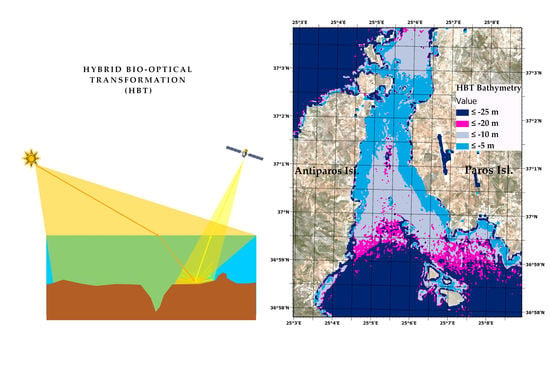A Hybrid Bio-Optical Transformation for Satellite Bathymetry Modeling Using Sentinel-2 Imagery
Abstract
:1. Introduction
2. Materials and Methods
2.1. The Study Area
2.2. Data Acquisition
2.2.1. The Field Data
2.2.2. Satellite Data
2.3. Methodology—Model Development
2.3.1. Sunglint Correction
2.3.2. Water Column Correction
2.3.3. Band Ratio Methodology
2.3.4. Computation of Bio-Optical Parameters
3. Results
3.1. Seabed Classification Results
3.2. Satellite Derived Bathymetry (SDB) Results
4. Discussion
5. Conclusions
Author Contributions
Funding
Conflicts of Interest
References
- Sathyendranath, S.; Platt, T.; Caverhill, C.M.; Warnock, R.E.; Lewis, M.R. Remote Sensing of Oceanic Primary Production: Computations using a Spectral Model. Deep-Sea Res. 1989, 36, 431–453. [Google Scholar] [CrossRef]
- Eugenio, F.; Marcello, J.; Martin, J. High-Resolution Maps of Bathymetry and Benthic Habitats in Shallow-Water Environments using Multispectral Remote Sensing Imagery. IEEE Trans. Geosci. Remote Sens. 2015, 53, 3539–3549. [Google Scholar] [CrossRef]
- Mavraeidopoulos, A.K.; Pallikaris, A.; Oikonomou, E. Satellite Derived Bathymetry (SDB) and Safety of Navigation. Int. Hydrogr. Rev. 2107, 17, 7–19. [Google Scholar]
- Muzirafuti, A.; Crupi, A.; Barreca, G.; Randazzo, G. Shallow water bathymetry by satellite image: A case study on the coast of San Lo Capo Peninsula, Northwestern Sicily, Italy. In Proceedings of the International Workshop on Metrology for the Sea, Genova, Italy, 3–5 October 2019. [Google Scholar]
- 15 Free Satellite Imagery Data Sources. Available online: https://gisgeography.com/free-satellite-imagery-data-list (accessed on 9 December 2018).
- Mobley, C.D.; Sundman, L.K. Hydrolight 4.1–Users Guide; Sequoia Scientific, Inc.: Redmond, WA, USA, 2000. [Google Scholar]
- Vermote, E.; Tanre, D.; Deuze, J.L.; Herman, M.; Morcrette, J.J.; Kotcenova, S.Y. Second Simulation of a Satellite Signal In the Solar Spectrum, 6S: An Overview. IEEE Trans. Geosci. Remote Sens. 1997, 35, 675–686. [Google Scholar] [CrossRef]
- Sterckx, S.; Knaeps, E.; Ruddick, K. Detection and correction of adjacency effects in hyperspectral airborne data of coastal and inland waters: The use of the near infrared similarity spectrum. Int. J. Remote Sens. 2011, 32, 6479–6505. [Google Scholar] [CrossRef]
- Wettle, M.; Brando, V.E. SAMBUCA–Semi–Analytical Model for Bathymetry, Un-mixing and Concetration Assessment; CSIRO: Clayton South Victoria, Australia, 2006. [Google Scholar]
- Wee Tang, K.K.; Mahmud, M.R.; Hussaini, A.; Abubakar, A.G. Evaluating Imagery-Derived bathymetry of seabed topography to support Marine Cadastre. Int. Arch. Photogramm. Remote Sens. Spat. Inf. Sci. 2019, XLII-4/W16, 633–639. [Google Scholar] [CrossRef]
- IHO. Publication C-55. Status of Hydrographic Surveying and Nautical Charting Worldwide; IHO: Monaco, 2011. [Google Scholar]
- Sagawa, T.; Yamashita, Y.; Okumura, T.; Yamanokuchi, T. Satellite Derived Bathymetry using Machine Learning and Multi-Temporal Satellite Images. Remote Sens. 2019, 11, 1155. [Google Scholar] [CrossRef]
- Richter, R.; Bachmann, M.; Schlaepfer, D. Correction of Cirrus Effects in Sentinel-2 Type of Imagery. Int. J. Remote Sens. 2011, 32, 2931–2941. [Google Scholar] [CrossRef]
- Pe’eri, S.; Parrish, C.; Azuike, C.; Alexander, L.; Armstrong, A. Satellite Remote Sensing as a Reconnaissance Tool for Assessing Nautical Chart Adequacy and Completeness. Mar. Geod. 2014, 37, 293–314. [Google Scholar] [CrossRef]
- EOMAP White Paper. EOMAP Satellite-Derived Bathymetry (SDB). Available online: http://www.eomap.com (accessed on 10 April 2014).
- Goodman, J.A.; Ping, L.-Z.; Ustin, S.L. Influence of Atmospheric and Sea-Surface Corrections on Retrieval of Bottom Depth and Reflectance Using a Semi-Analytical Model: A Case Study in Kaneohe Bay, Hawaii. Appl. Opt. 2008, 47, F1–F11. [Google Scholar] [CrossRef]
- Kay, S.; Hedley, J.D.; Lavender, S. Sun Glint Correction of High and Low Spatial Resolution. Remote Sens. 2009, 1, 697–730. [Google Scholar] [CrossRef]
- Maritorena, S.; Morel, A.; Gentili, B. Diffuse Reflectance of Oceanic Shallow Waters: Influence of Water Depth and Bottom Albedo. Limnol. Oceanogr. 1994, 39, 1689–1703. [Google Scholar] [CrossRef]
- Lyzenga, D. Remote Sensing of Bottom Reflectance and Water Attenuation Parameters in Shallow Water using Aircraft and Landsat Data. Int. J. Remote Sens. 1981, 2, 71–82. [Google Scholar] [CrossRef]
- Stumpf, R.P.; Holderied, K.; Sinclair, M. Determination of water depth with high-resolution satellite imagery over variable bottom types. Limnol. Oceanogr. 2003, 48, 547–556. [Google Scholar] [CrossRef]
- Leiper, I.A.; Phin, S.R.; Roelfsema, C.M.; Joyce, K.E.; Dekker, A.G. Mapping Coral Reef Benthos, Substrates and Bathymetry using Compact Airborne Spectrographic Imager (CASI) Data. Remote Sens. 2014, 6, 6423–6445. [Google Scholar] [CrossRef]
- Traganos, D.; Reinartz, P. Mapping Mediterranean Seagrasses with Sentinel-2 Imagery. Mar. Pollut. Bull. 2018, 134, 197–209. [Google Scholar] [CrossRef]
- Lee, Z.-P.; Carder, K.L.; Arnone, R.A. Deriving Inherent Optical Properties from Water Color: A Multiband Quasi-Analytical Argorithm for Optically Deep Waters. Appl. Opt. 2002, 41, 5755–5772. [Google Scholar] [CrossRef]
- Pope, R.M.; Fry, E.S. Absorption Spectrum (380-700 nm) of Pure Water 2. Intergrating Gavity Measurements. Appl. Opt. 1997, 36, 8710–8723. [Google Scholar] [CrossRef]
- Morel, A. Optical Properties of Pure Water and Pure Seawater. Opt. Asp. Oceanogr. 1974, 1, 1–24. [Google Scholar]
- Hedley, J.D.; Roelfsema, C.M.; Chollett, I.; Harborne, A.R.; Heron, S.F.; Weeks, S.; Skirving, W.J.; Strong, A.E.; Eakin, C.M.; Christensen, T.R.L.; et al. Remote Sensing of Coral Reefs for Monitoring and Management: A Review. Remote Sens. 2016, 8, 118. [Google Scholar] [CrossRef]
- Werdell, J.; Mckinna, L.I.W.; Boss, E.; Ackleson, S.G.; Craig, S.E.; Gregg, W.W.; Lee, Z.; Maritorena, S.; Roesler, C.S.; Rousseaux, C.S.; et al. An overview of approaches and challenges for retrieving marine inherent optical properties from ocean color remote sensing. Progress Oceanogr. 2018, 160, 186–212. [Google Scholar] [CrossRef] [PubMed]
- NOAA. Nautical Chart User’s Manual; NOAA: Washington, DC, USA, 1997. [Google Scholar]
- EMSA. Annual Overview of Marine Casualties and Incidents 2018; EMSA: Lisbon, Portugal, 2018. [Google Scholar]
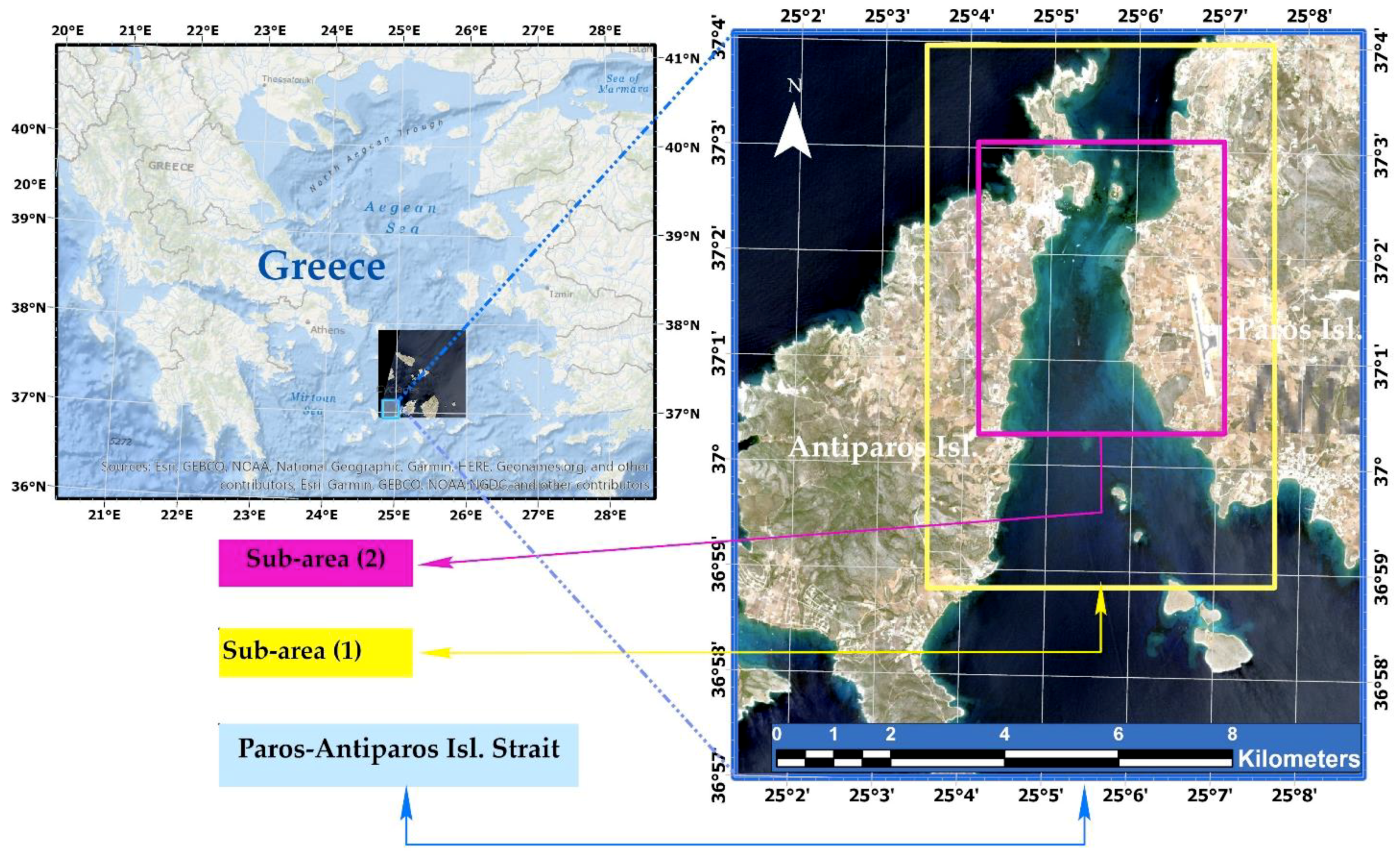
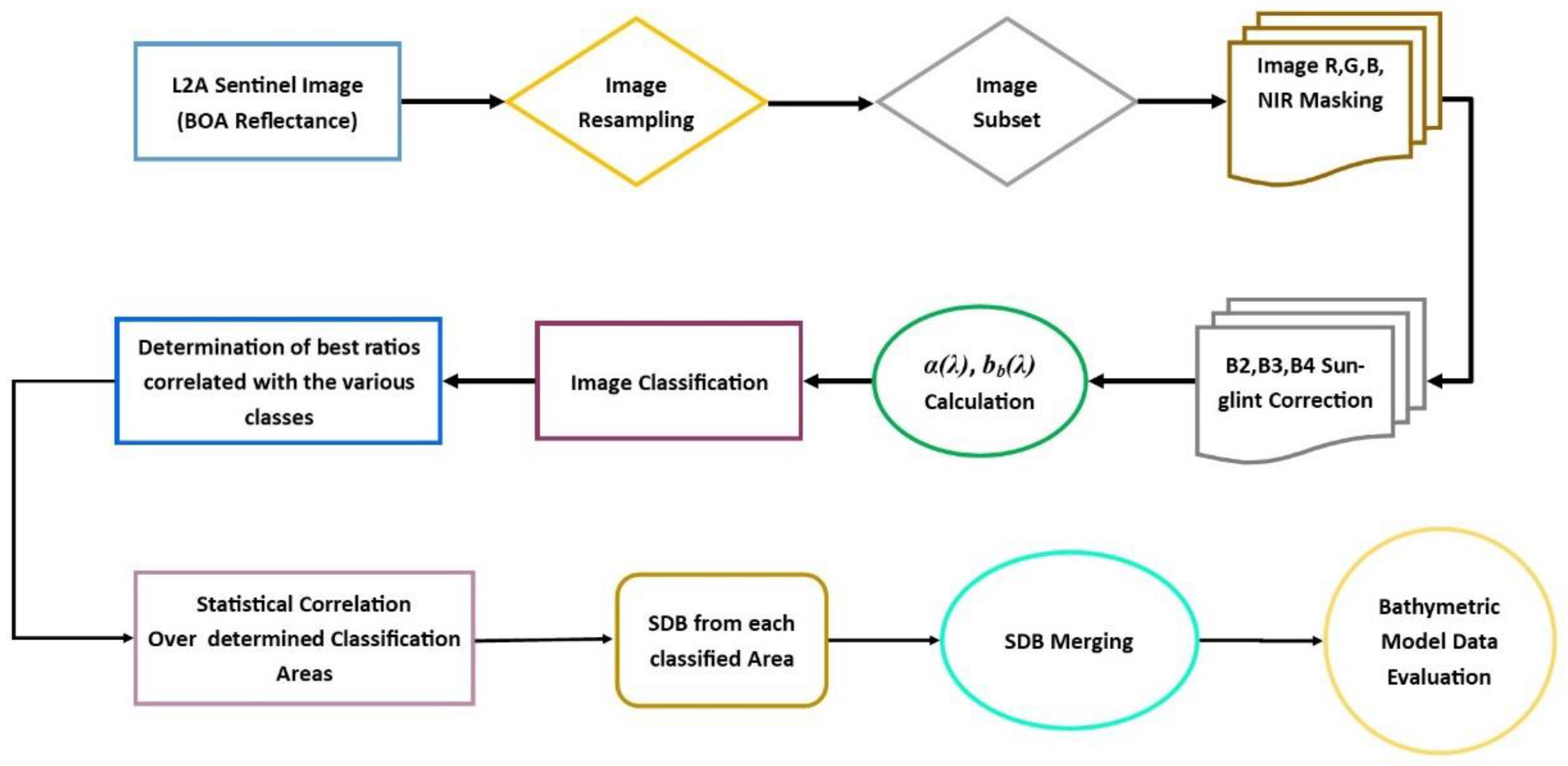


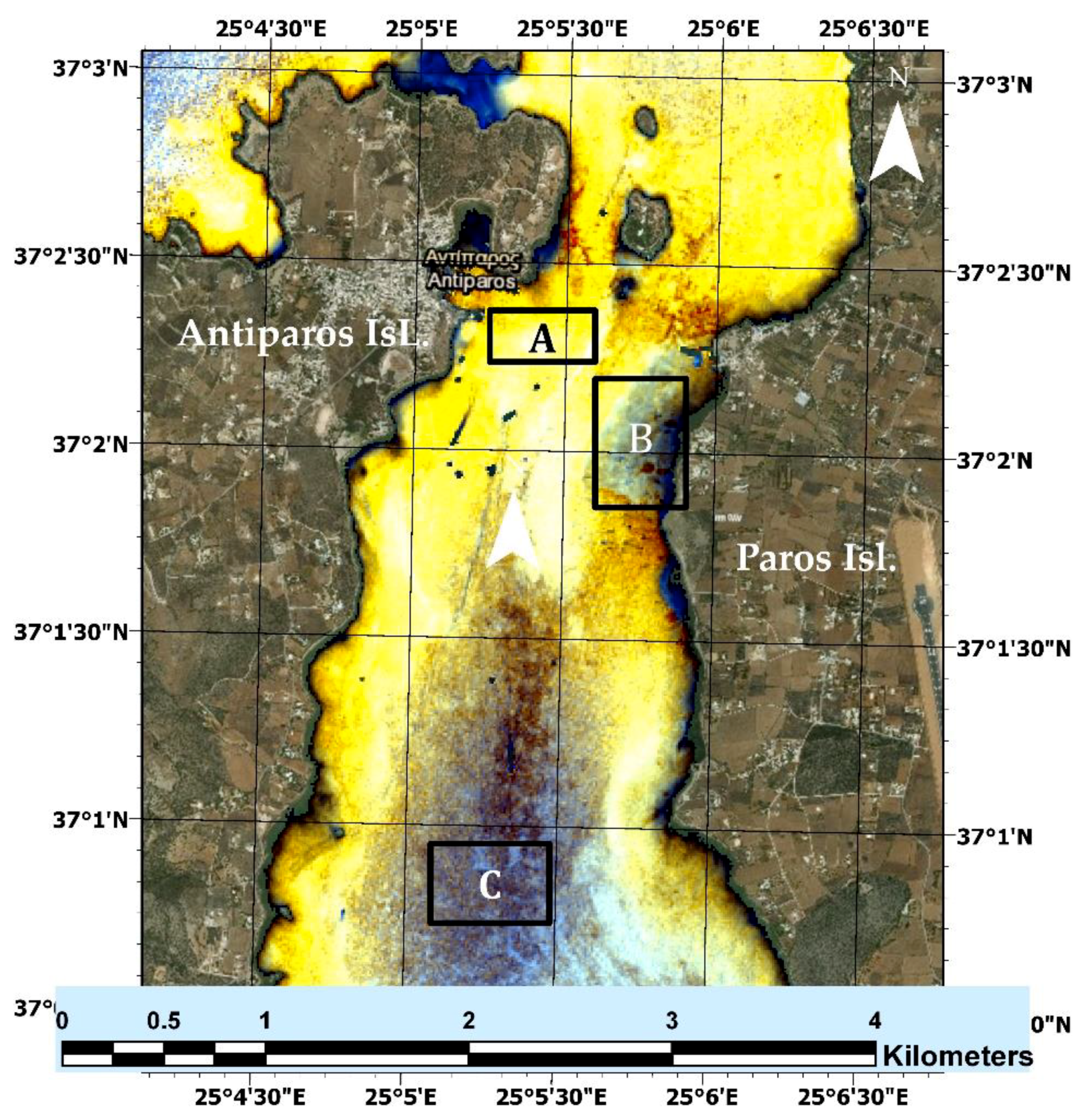
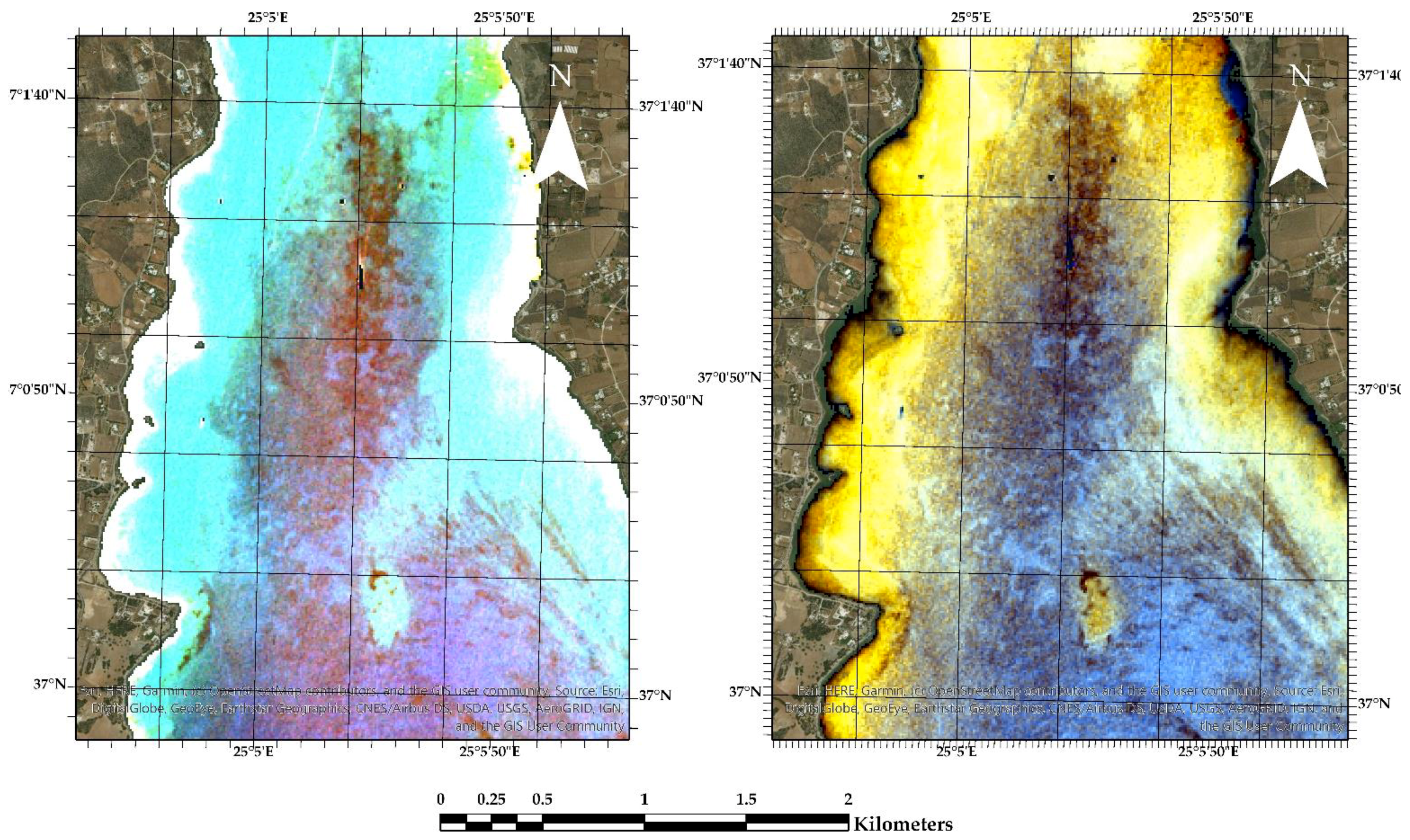
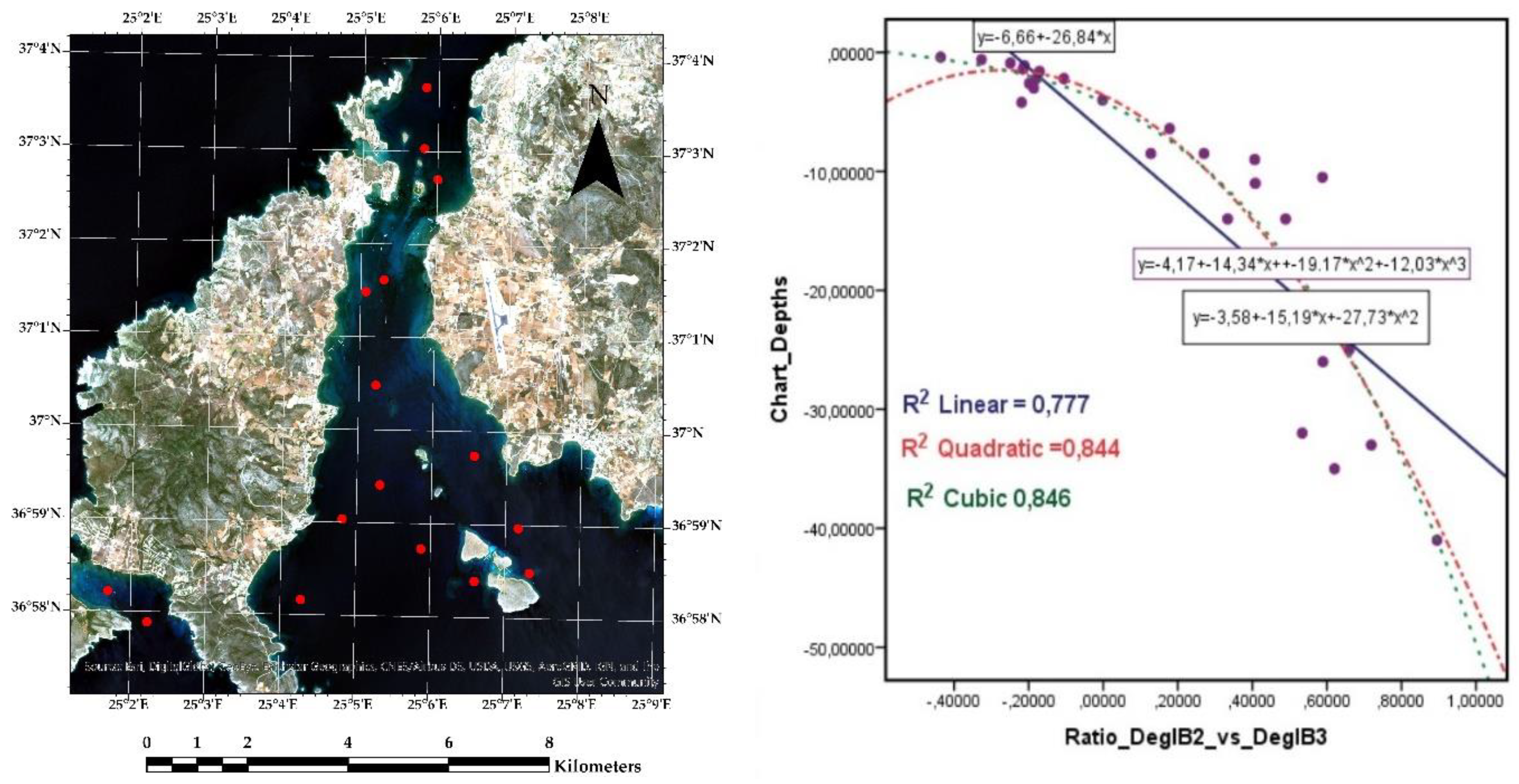
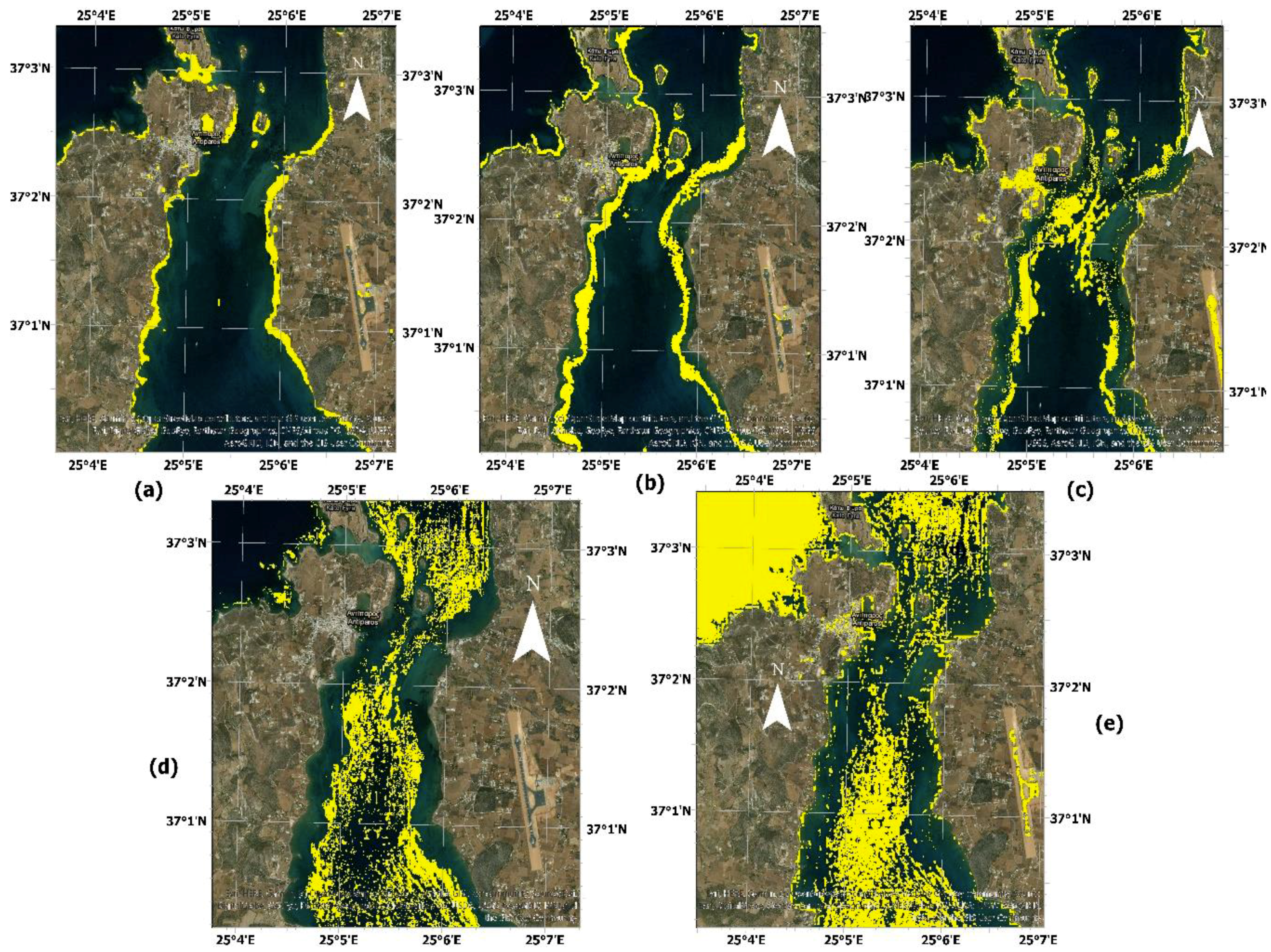

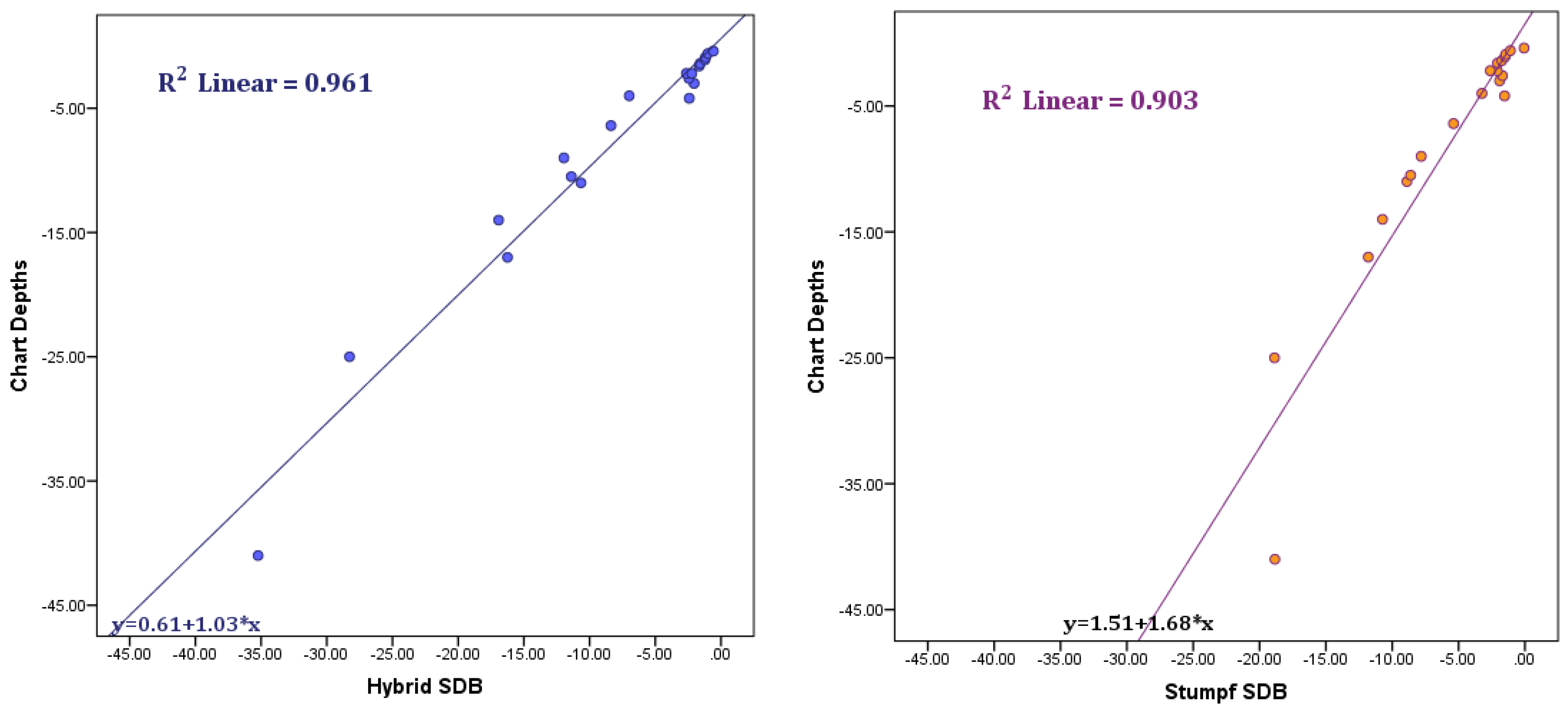
| Seabed Class | Bio-Optical Characteristics | |
|---|---|---|
| Suspended Particles | Degl(B3) > Degl(B2) > Degl(B1) > Degl(B4) bb(B1) > bb(B2) > bb(B3) > bb(B4) α(B1) > α(B4) > α(B2) > α(B3) Kd(B1) > Kd(B2) > Kd(B3) > Kd(B4) | |
| Seaweed | Dense Meadows | Degl(B3) > Degl(B2) > Degl(B1) > Degl(B4) bb(B1) > bb(B2) > bb(B3) > bb(B4) α(B4) > α(B1) > α(B2) > α(B3) Kd(B1) > Kd(B2) > Kd(B4) > Kd(B3) |
| Sparse Meadows | Degl(B3) > Degl(B1) > Degl(B2) > Degl(B4) bb(1) > bb(B2) > bb(B3) > bb(B4) α(B4) > α(B1) > α(B2) > α(B3) Kd(B1) > Kd(B2) > Kd(B3) > Kd(B4) | |
| Offshore | Shallow Waters | Degl(B2) > Degl(B1) > Degl(B3) > Degl(B4) bb(1) > bb(B2) > bb(B3) > bb(B4) α(B4) > α(B1) > α(B2) > α(B3) Kd(B1) > Kd(B4) > Kd(B2) > Kd(B3) |
| Deep Waters | Degl(B1) > Degl(B2) > Degl(B3) > Degl(B4) bb(B1) > bb(B2) > bb(B3) > bb(B4) α(B4) > α(B1) > α(B2) > α(B3) Kd(B1) > Kd(B2) > Kd(B4) > Kd(B3) | |
| Bio-Optical Parameter | Units | Band | Min | Max |
|---|---|---|---|---|
| Backscattering Coefficient bb | (m−1) | B1 | 0.11 | 0.42 |
| B2 | 0.09 | 0.35 | ||
| B3 | 0.07 | 0.25 | ||
| B4 | 0.05 | 0.18 | ||
| Total Absorption Coefficient α | (m−1) | B1 | 0.14 | 0.51 |
| B2 | 0.11 | 0.48 | ||
| B3 | 0.07 | 0.38 | ||
| B4 | 0.44 | 0.49 | ||
| Diffuse Attenuation Coefficient Κd | Unitless | B1 | 0.74 | 2.10 |
| B2 | 0.24 | 1.50 | ||
| B3 | 0.17 | 1.22 | ||
| B4 | 0.74 | 1.23 |
| Seabed Class | Ratio | R2 (Linear) | R2 (Quadratic) |
|---|---|---|---|
| Suspended particles | 0.960 | 0.969 | |
| Dense flora | 0.878 | 0.931 | |
| Sparse flora | 0.903 | 0.908 | |
| Offshore shallow waters | 0.880 | 0.935 | |
| Offshore deep waters | 0.909 | 0.973 |
© 2019 by the authors. Licensee MDPI, Basel, Switzerland. This article is an open access article distributed under the terms and conditions of the Creative Commons Attribution (CC BY) license (http://creativecommons.org/licenses/by/4.0/).
Share and Cite
Mavraeidopoulos, A.K.; Oikonomou, E.; Palikaris, A.; Poulos, S. A Hybrid Bio-Optical Transformation for Satellite Bathymetry Modeling Using Sentinel-2 Imagery. Remote Sens. 2019, 11, 2746. https://doi.org/10.3390/rs11232746
Mavraeidopoulos AK, Oikonomou E, Palikaris A, Poulos S. A Hybrid Bio-Optical Transformation for Satellite Bathymetry Modeling Using Sentinel-2 Imagery. Remote Sensing. 2019; 11(23):2746. https://doi.org/10.3390/rs11232746
Chicago/Turabian StyleMavraeidopoulos, Athanasios K., Emmanouil Oikonomou, Athanasios Palikaris, and Serafeim Poulos. 2019. "A Hybrid Bio-Optical Transformation for Satellite Bathymetry Modeling Using Sentinel-2 Imagery" Remote Sensing 11, no. 23: 2746. https://doi.org/10.3390/rs11232746
APA StyleMavraeidopoulos, A. K., Oikonomou, E., Palikaris, A., & Poulos, S. (2019). A Hybrid Bio-Optical Transformation for Satellite Bathymetry Modeling Using Sentinel-2 Imagery. Remote Sensing, 11(23), 2746. https://doi.org/10.3390/rs11232746





